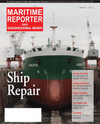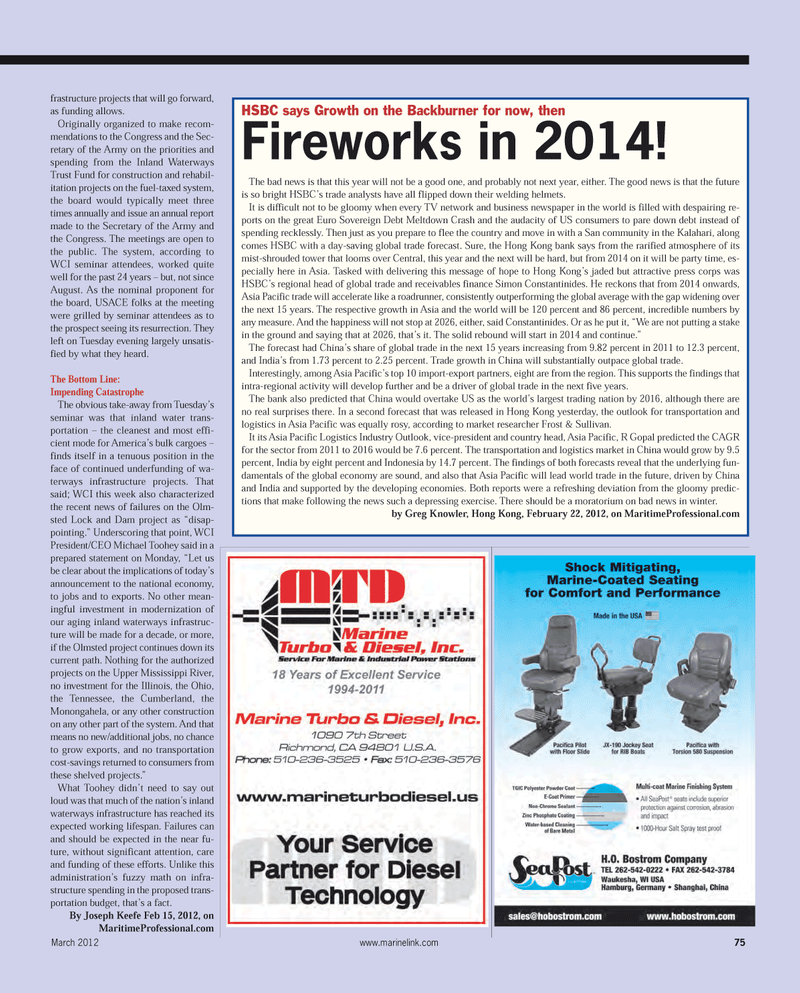
Page 75: of Maritime Reporter Magazine (March 2012)
The Ship Repair Edition
Read this page in Pdf, Flash or Html5 edition of March 2012 Maritime Reporter Magazine
frastructure projects that will go forward, as funding allows. Originally organized to make recom- mendations to the Congress and the Sec-retary of the Army on the priorities and spending from the Inland Waterways Trust Fund for construction and rehabil- itation projects on the fuel-taxed system, the board would typically meet three times annually and issue an annual reportmade to the Secretary of the Army and the Congress. The meetings are open to the public. The system, according to WCI seminar attendees, worked quite well for the past 24 years ? but, not since August. As the nominal proponent for the board, USACE folks at the meeting were grilled by seminar attendees as tothe prospect seeing its resurrection. They left on Tuesday evening largely unsatis- fied by what they heard. The Bottom Line: Impending Catastrophe The obvious take-away from Tuesday?s seminar was that inland water trans- portation ? the cleanest and most effi- cient mode for America?s bulk cargoes ? finds itself in a tenuous position in the face of continued underfunding of wa- terways infrastructure projects. That said; WCI this week also characterized the recent news of failures on the Olm- sted Lock and Dam project as ?disap-pointing.? Underscoring that point, WCI President/CEO Michael Toohey said in a prepared statement on Monday, ?Let us be clear about the implications of today?s announcement to the national economy, to jobs and to exports. No other mean- ingful investment in modernization of our aging inland waterways infrastruc- ture will be made for a decade, or more,if the Olmsted project continues down its current path. Nothing for the authorizedprojects on the Upper Mississippi River, no investment for the Illinois, the Ohio, the Tennessee, the Cumberland, the Monongahela, or any other construction on any other part of the system. And that means no new/additional jobs, no chance to grow exports, and no transportation cost-savings returned to consumers from these shelved projects.? What Toohey didn?t need to say out loud was that much of the nation?s inland waterways infrastructure has reached its expected working lifespan. Failures can and should be expected in the near fu- ture, without significant attention, care and funding of these efforts. Unlike this administration?s fuzzy math on infra- structure spending in the proposed trans-portation budget, that?s a fact. By Joseph Keefe Feb 15, 2012, on MaritimeProfessional.com March 2012 www.marinelink.com 75HSBC says Growth on the Backburner for now, then Fireworks in 2014! The bad news is that this year will not be a good one, and probably not next year, either. The good news is that the future is so bright HSBC?s trade analysts have all flipped down their welding helmets. It is difficult not to be gloomy when every TV network and business newspaper in the world is filled with despairing re- ports on the great Euro Sovereign Debt Meltdown Crash and the audacity of US consumers to pare down debt instead of spending recklessly. Then just as you prepare to flee the country and move in with a San community in the Kalahari, along comes HSBC with a day-saving global trade forecast. Sure, the Hong Kong bank says from the rarified atmosphere of its mist-shrouded tower that looms over Central, this year and the next will be hard, but from 2014 on it will be party time, es- pecially here in Asia. Tasked with delivering this message of hope to Hong Kong?s jaded but attractive press corps was HSBC?s regional head of global trade and receivables finance Simon Constantinides. He reckons that from 2014 onwards, Asia Pacific trade will accelerate like a roadrunner, consistently outperforming the global average with the gap widening over the next 15 years. The respective growth in Asia and the world will be 120 percent and 86 percent, incredible numbers by any measure. And the happiness will not stop at 2026, either, said Constantinides. Or as he put it, ?We are not putting a stake in the ground and saying that at 2026, that?s it. The solid rebound will start in 2014 and continue.? The forecast had China?s share of global trade in the next 15 years increasing from 9.82 percent in 2011 to 12.3 percent, and India?s from 1.73 percent to 2.25 percent. Trade growth in China will substantially outpace global trade. Interestingly, among Asia Pacific?s top 10 import-export partners, eight are from the region. This supports the findings that intra-regional activity will develop further and be a driver of global trade in the next five years. The bank also predicted that China would overtake US as the world?s largest trading nation by 2016, although there are no real surprises there. In a second forecast that was released in Hong Kong yesterday, the outlook for transportation and logistics in Asia Pacific was equally rosy, according to market researcher Frost & Sullivan. It its Asia Pacific Logistics Industry Outlook, vice-president and country head, Asia Pacific, R Gopal predicted the CAGR for the sector from 2011 to 2016 would be 7.6 percent. The transportation and logistics market in China would grow by 9.5 percent, India by eight percent and Indonesia by 14.7 percent. The findings of both forecasts reveal that the underlying fun- damentals of the global economy are sound, and also that Asia Pacific will lead world trade in the future, driven by China and India and supported by the developing economies. Both reports were a refreshing deviation from the gloomy predic- tions that make following the news such a depressing exercise. There should be a moratorium on bad news in winter. by Greg Knowler, Hong Kong, February 22, 2012, on MaritimeProfessional.com MR March 12 # 10 (73-80):MR Template 3/6/2012 8:49 AM Page 75

 74
74

 76
76
